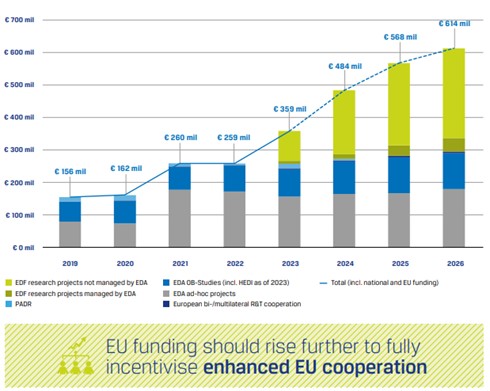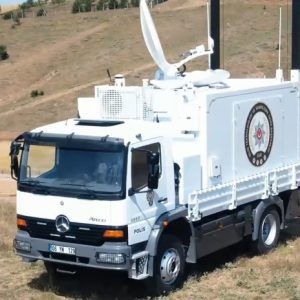EU defence spending in 2025 is set to reach a record €381 billion, according to fresh data from the European Defence Agency (EDA). The headline number matters, yet the composition matters more: under NATO’s new 3.5% + 1.5% framework, Europe must turn today’s budget momentum into deployable force structure, munitions depth, and resilient infrastructure. This analysis explains what is actually changing, who moves first, and why the cost curve rises sharply from here. [1][2]
What the €381bn headline does—and doesn’t—tell us
The EDA’s projection shows EU defence spending in 2025 increasing roughly 10% year-on-year from €343bn in 2024 to €381bn in 2025. Investment items—new weapon systems, platforms, stockpiles, and upgrades—rise to “close to €130bn.” R&D could reach ~€17bn. On the share of GDP, the bloc crosses the 2% line for the first time in EDA records, still below NATO’s new benchmark. [1]
In practice, that means 2025 is a staging year rather than a finish line. EU defence spending in 2025 will improve readiness and replenish ammunition—critical after two years of surge support to Ukraine—but the gap to NATO’s core 3.5% target remains significant. Translating the headline into force elements: more air and missile defence batteries, higher-rate artillery production, and expanded depot capacity should lead the queue.
Key facts
- €381bn – EU defence spending 2025 (projected). [1]
- ~€130bn – 2025 defence investment (procurement + major upgrades). [2]
- €343bn → €381bn – 2024 to 2025 increase (~10%). [1]
- 3.5% + 1.5% – NATO’s new two‑tier spending rule by 2035. [3][4]
- €150bn SAFE – EU loans facility fully subscribed by 19 member states. [5][6]
NATO’s 3.5% + 1.5%: from accounting to capability
At the 2025 NATO summit, allies endorsed a 5% of GDP effort by 2035, split between 3.5% for core defence (forces, equipment, operations) and up to 1.5% for related resilience (dual‑use infrastructure, cyber, energy security). This codifies what commanders have seen since 2022: munitions and manpower alone cannot solve logistics, industrial bottlenecks, or infrastructure limits. [3][4][7]
How big is the ask? The EDA’s leadership estimates that meeting the 3.5% core target alone implies €630bn+ annually for the EU by the early 2030s—nearly doubling today’s outlays. That is consistent with internal alliance math and underscores why EU defence spending 2025, while historic, is a floor rather than a ceiling. [2]
Financing the ramp: SAFE and the industrial back‑end
The Commission’s SAFE plan provides up to €150bn in long‑maturity, competitively priced loans backed by the EU budget to fast‑track major procurement. Nineteen member states have already subscribed, signalling demand for air and missile defence, drones and counter‑UAS, ISR, and cyber. For primes and Tier‑1s, SAFE reduces demand uncertainty; for SMEs, it de‑risks tooling expansions and skills hiring. [5][6]
Industrial implications are immediate. The marginal euro must buy throughput: multi‑source rocket motor lines, modular launcher bays, and NATO‑interoperable C2 updates. EU defence spending 2025 should therefore prioritise predictable multi‑year contracts with indexed pricing and delivery‑rate incentives. Without that, the 2026–2029 window will suffer from the same single‑point bottlenecks that slowed artillery and air defence replenishment in 2023–2024.
Where the money likely goes in 2025–2027
Integrated air & missile defence (IAMD): From Patriots and SAMP/T to SHORAD and counter‑UAS, demand will stay elevated as Russia’s long‑range strike campaign evolves. The 1.5% infrastructure line also points to hardening: dispersed shelters, mobile power, and runway repair kits. [1]
Artillery and deep fires: Ammunition plants will expand capacity and shift to 24/7 cycles; precision‑guided rockets and cruise missiles move to framework contracts. EU defence spending 2025 should lock in multi‑year buys to give vendors capital‑market leverage.
Maritime security and ISR: Persistent surveillance (MPA, MALE UAVs, maritime radars) plus seabed infrastructure security will compete for funds under the resilience bucket, particularly around the North and Baltic Seas. [3]
Strategic risk: timelines, tariffs, and politics
Two risks could slow progress. First, timelines: industrial lead times on air defence missiles, large‑body UAVs, and radar arrays run 18–36 months even after capital spending. Second, politics: if transatlantic tariff policies widen budget deficits or depress growth, some EU economies may hesitate to accelerate toward 3.5% by 2030. AP reporting already suggests only a handful of Allies currently meet the new core target. EU defence spending 2025 buys time, but not immunity from macro‑shocks. [7]
Bottom line
EU defence spending 2025 marks an inflection point—from incremental reconstitution to deliberate rearmament. The €381bn figure is a necessary waypoint, not the destination. The decisive test is whether governments convert budgets into repeatable output: higher monthly missile lots, deeper stocks, deployable brigades, and hardened networks. If they do, the 3.5% target becomes achievable; if they don’t, 2025’s record will read as a plateau.
Related on Defence Agenda: NATO releases 2025 defence expenditure figures: what changed and why it matters.
Benchmark analysis: See SIPRI’s assessment of NATO’s new spending target for context on risks and trade‑offs.
References
- European Defence Agency (EDA) – EU defence spending is projected to reach €381bn in 2025; investment ~€130bn; 2024 €343bn.
- AFP via SpaceWar – EU defence spending to hit record €381bn in 2025; Kallas quote; €630bn/yr to meet 3.5%.
- Reuters – What is NATO’s new 5% defence spending target?.
- NATO – Defence expenditures and the 3.5% commitment (official).
- Financial Times – EU to tap entire €150bn SAFE loans‑for‑arms programme.
- European Commission – SAFE: Security Action for Europe (official overview).
- Associated Press – All NATO members projected to hit 2%; few meet 3.5% core target.











